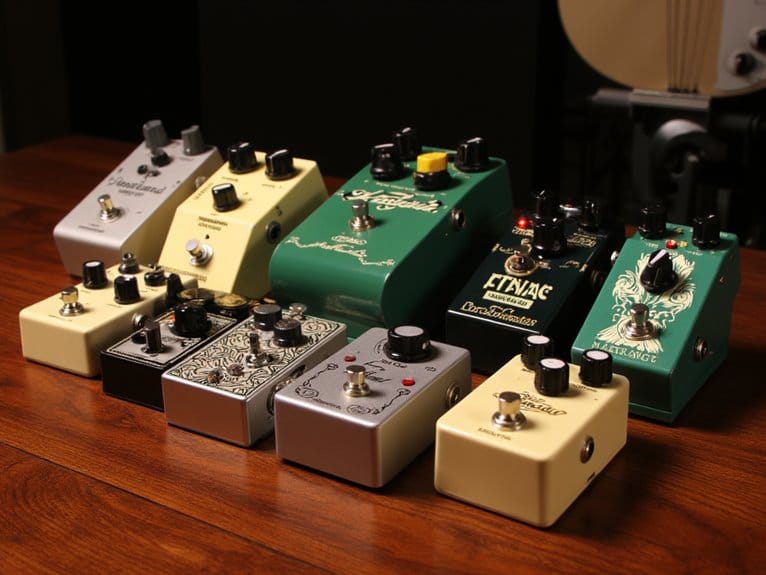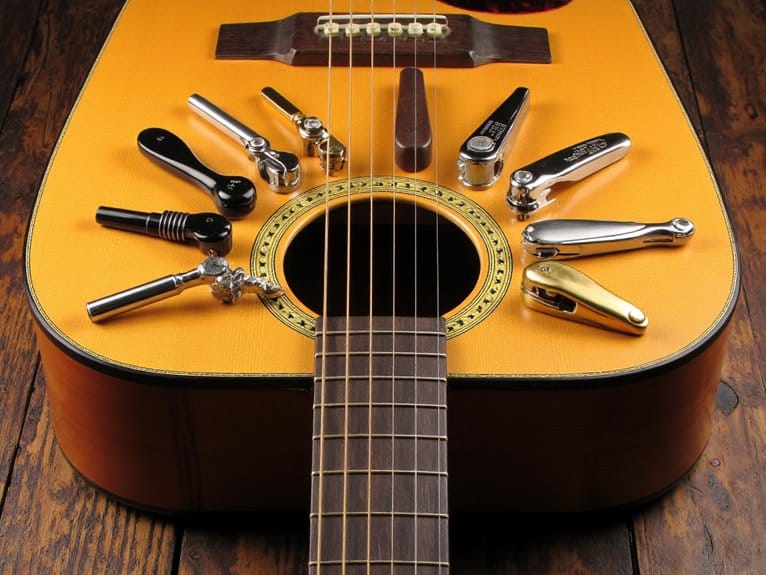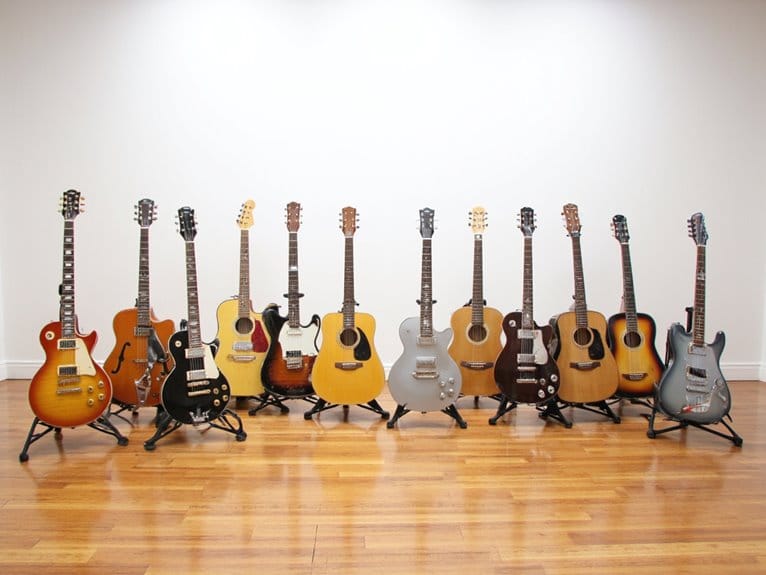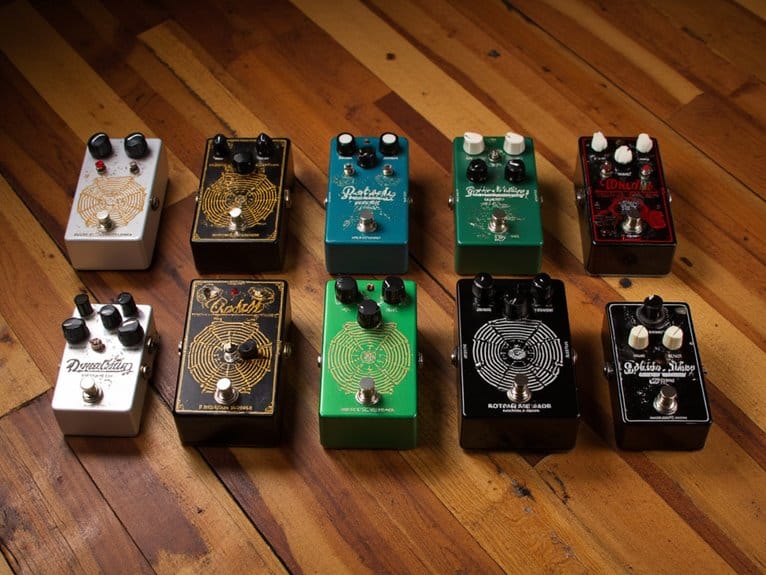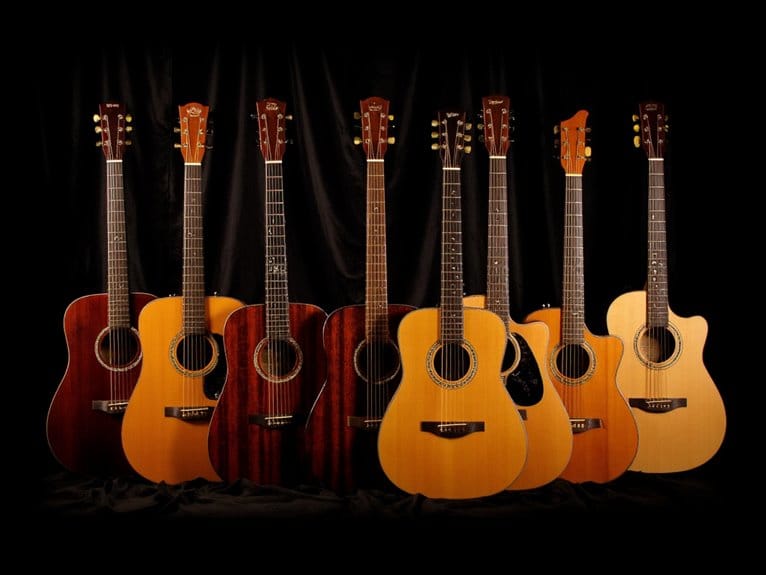10 Best Acoustic Pedal Simulators That Will Transform Your Electric Guitar Sound
After testing dozens of acoustic simulators, I’ve found the Boss AC-3 delivers the most convincing acoustic transformation with its four versatile modes, while the compact MOOER Acoustikar offers excellent value for home practice. The Rowin Acoustic AC Stage provides budget-friendly true bypass switching, and the ISET Acoustic Simulator handles rock contrasts well despite some noise issues. For multi-effects capabilities, the SOOMME packs chorus, delay, and nine reverb options into one lightweight pedal, though reliability varies. Below, I’ll break down each pedal’s strengths and ideal applications.
We are supported by our audience. When you purchase through links on our site, we may earn an affiliate commission, at no extra cost for you. Learn more.
Notable Insights
- Boss AC-3 offers four versatile simulation modes for live performances requiring quick acoustic tone changes.
- MOOER Acoustikar provides compact, budget-friendly acoustic simulation with three modes in a lightweight 5.6-ounce design.
- Hotone Omni AC delivers fifteen high-quality acoustic simulations with detailed EQ controls for realistic tone shaping.
- SOOMME Acoustic Pedal combines acoustic simulation with multiple effects including chorus, delay, and nine reverb options.
- Most acoustic simulators require 9V DC power and range from $25 budget models to $250+ premium units.
Boss AC-3 Acoustic Simulator Pedal
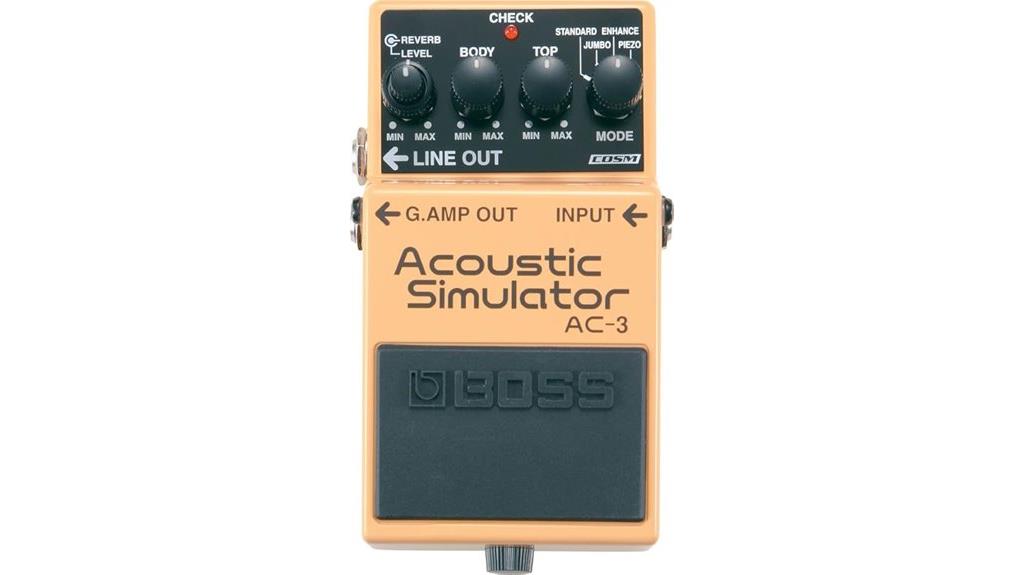
When you’re a versatile guitarist who needs to switch between electric and acoustic tones during live performances, the Boss AC-3 Acoustic Simulator Pedal delivers authentic acoustic modeling that transforms your electric guitar’s signal into convincing acoustic textures. This compact pedal offers four distinct simulation modes—Standard, Jumbo, Enhanced, and Piezo-equipped—giving you extensive tonal options that cover everything from bright strumming patterns to warm fingerpicked melodies. The built-in reverb, specifically optimized for acoustic guitar simulation, adds spatial depth that enhances the organic feel of your transformed sound, making it surprisingly effective for studio recordings and live applications alike.
Best For: Guitarists who need to switch between electric and acoustic tones during live performances or recording sessions without changing instruments.
Pros:
- Four distinct simulation modes (Standard, Jumbo, Enhanced, and Piezo-equipped) provide extensive tonal versatility
- Built-in reverb specifically optimized for acoustic guitar simulation adds authentic spatial depth
- Compact pedal format makes it easy to integrate into existing pedalboards for live and studio use
Cons:
- May not completely replicate the nuanced feel and response of a real acoustic guitar
- Limited to acoustic simulation only, lacking additional effects or modeling options
- Requires proper setup and technique to achieve the most convincing acoustic sound
MOOER Acoustikar Acoustic Guitar Pedal Simulator (3 Modes)
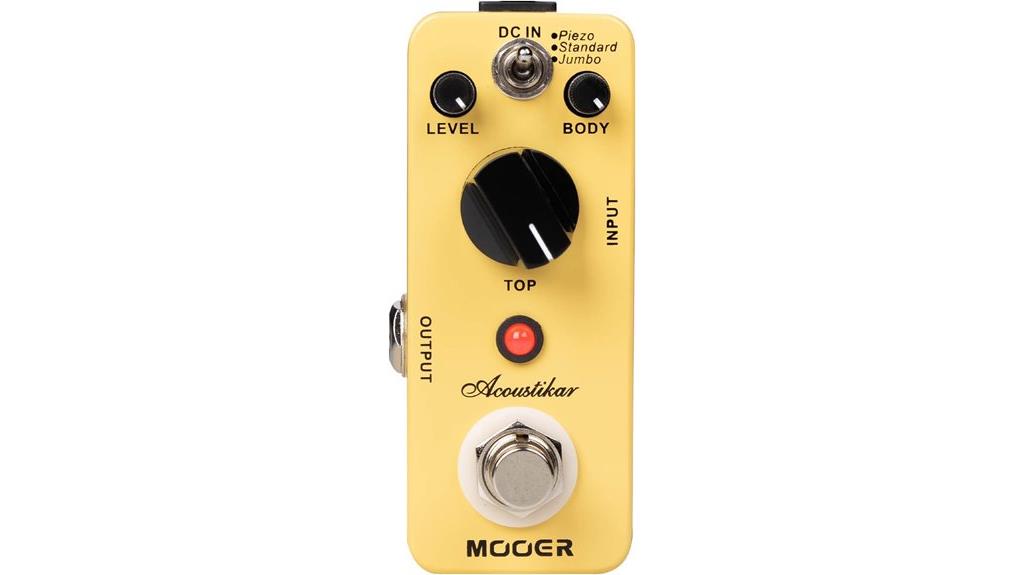
The MOOER Acoustikar stands out as a remarkably compact solution for electric guitarists who need acoustic tones without the bulk or expense of a full-sized acoustic guitar, offering three distinct simulation modes—Piezo, Standard, and Jumbo—that transform your electric guitar’s signal into convincing acoustic textures. You’ll appreciate its 3.54-inch footprint and 5.6-ounce weight, though you’ll need to purchase a 9V power adapter separately. The pedal works best at your signal chain’s front, delivering solid analog processing that’s particularly effective for quiet practice sessions through headphones. While it won’t replace a genuine acoustic guitar’s warmth, you’ll find it serves admirably for jamming and casual performance needs.
Best For: Electric guitarists who want acoustic tones for home practice, quiet jamming sessions, and recording without the need for a full acoustic guitar.
Pros:
- Three distinct acoustic simulation modes (Piezo, Standard, Jumbo) provide versatile tone options
- Extremely compact size (3.54″ x 3.54″) and lightweight (5.6 oz) make it pedalboard-friendly
- Affordable price point offers good value for acoustic simulation capabilities
Cons:
- Requires separate purchase of 9V power adapter as it’s not included
- Sound can be sterile compared to real acoustic guitars and may disappoint in live performance settings
- Limited functionality without additional preamp or effects to enhance tone quality
Rowin Acoustic AC Stage Acoustic Guitar Simulator Pedal
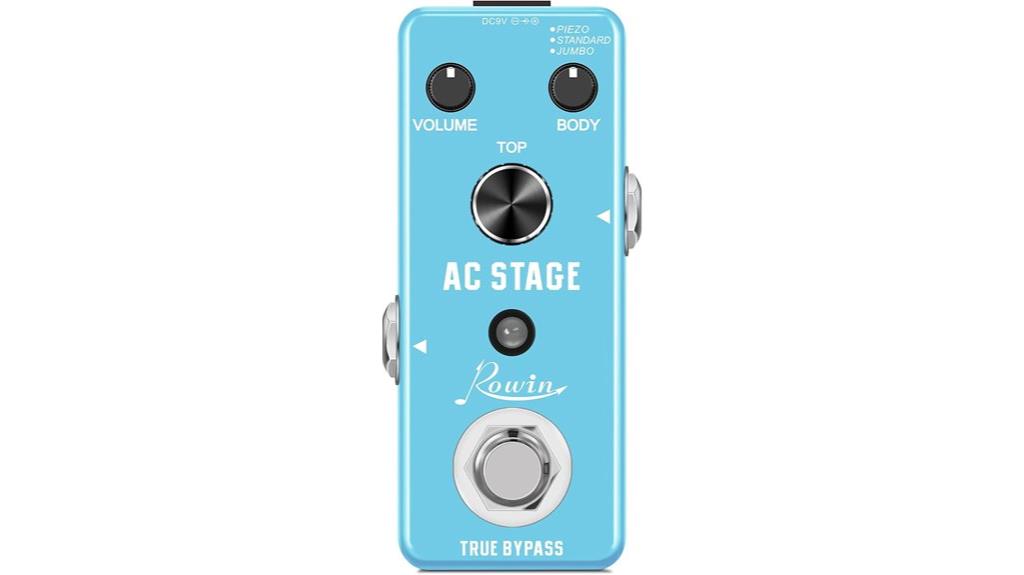
Budget-conscious guitarists seeking versatile acoustic simulation will find the Rowin Acoustic AC Stage Acoustic Guitar Simulator Pedal delivers remarkable value through its three distinct sound modes, each tailored to different musical contexts and tonal preferences. The Piezo mode provides bright, cutting simulation with reduced body resonance, while Standard mode offers balanced acoustic character that’ll satisfy most performance situations. Jumbo mode delivers full-bodied depth that mimics larger-body acoustic guitars effectively. You’ll appreciate the true bypass circuitry that maintains signal integrity when disengaged, plus the LED indicator that clearly displays operational status. This pedal’s surprising versatility extends beyond guitars, restoring natural warmth to electric violins and similar instruments admirably.
Best For: Budget-conscious guitarists and electric violin players who want versatile acoustic simulation with multiple tonal options for different musical contexts.
Pros:
- Three distinct sound modes (Piezo, Standard, Jumbo) provide versatility for different musical styles and tonal preferences
- True bypass circuitry maintains signal integrity when the pedal is disengaged
- Works effectively with multiple instruments beyond guitars, including electric violins
Cons:
- DC 9V power adapter sold separately, adding to the total cost
- Piezo mode has reduced body resonance which may not suit all acoustic simulation needs
- Compact design may make it difficult to operate in cramped pedalboard setups
ISET Acoustic Simulator Guitar Effect Pedal for Electric Guitar Bass
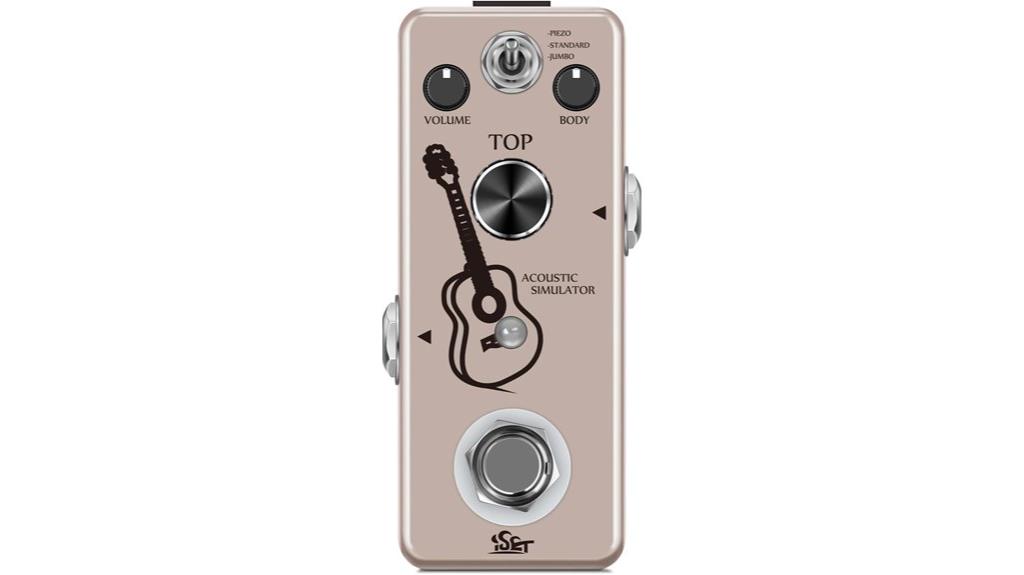
Although simplicity often comes at the cost of versatility, the ISET Acoustic Simulator Guitar Effect Pedal proves that budget-friendly gear can deliver surprisingly effective results for musicians who need quick acoustic tones without the complexity of multi-knob interfaces. At just $25, this compact pedal offers body and top controls that function as bass and treble adjustments, creating that characteristic mid-scoop effect essential for acoustic simulation. While it won’t fool anyone into thinking you’re playing a Martin, it excels at providing usable acoustic parts for rock and metal songs where you need clean contrast against distorted sections, though you’ll notice some minor noise during quiet passages.
Best For: Budget-conscious guitarists and beginners who need simple acoustic simulation for live performances or adding clean contrast sections to rock and metal songs without investing in complex multi-effects pedals.
Pros:
- Affordable at $25 with straightforward one-switch design and effective mid-scoop acoustic simulation
- Compact and reliable build quality with simple body/top controls for quick tonal adjustments
- Works well for live performances as both an acoustic simulator and mute switch
Cons:
- Minor noise and hiss during quiet passages, especially noticeable in studio settings
- Limited versatility due to simple control layout compared to more complex pedals
- DC jack stability issues reported by some users affecting long-term reliability
Acoustic Guitar Effect Pedal with 3 Modes True Bypass

SOOMME’s Acoustic Pedal Guitar Effect stands out as an ideal choice for guitarists who need versatile sound experimentation without breaking the bank, since it packs an impressive array of effects including chorus, flanger, distortion, delay, and nine reverb options into a compact 7.7-ounce aluminum housing. You’ll appreciate the true bypass feature that maintains your guitar’s natural tone when disengaged, while the well-labeled knobs make sound adjustments straightforward for quick tweaking during performances. Though it lacks expression pedal input, which might limit advanced users, the 4.0-star rating from 46 customers reflects solid value at this price point, despite occasional reliability concerns like potential flanger failures after extended use.
Best For: Budget-conscious guitarists seeking versatile sound experimentation with multiple effects including chorus, flanger, distortion, delay, and nine reverb options in a compact, easy-to-use pedal.
Pros:
- Wide range of effects (chorus, flanger, distortion, delay, and 9 reverb options) packed into a lightweight 7.7-ounce aluminum housing
- True bypass feature maintains guitar’s natural tone when disengaged, with well-labeled knobs for quick sound adjustments
- Strong value proposition with 4.0-star customer rating and affordable pricing for the feature set offered
Cons:
- Lacks expression pedal input which limits flexibility and advanced control options for experienced users
- Reliability concerns with some components, including reported flanger pedal failures after approximately 5 months of use
- Tuning precision issues noted by some users, which could affect performance accuracy
Hotone Omni AC Simulation Guitar Bass Effects Pedal
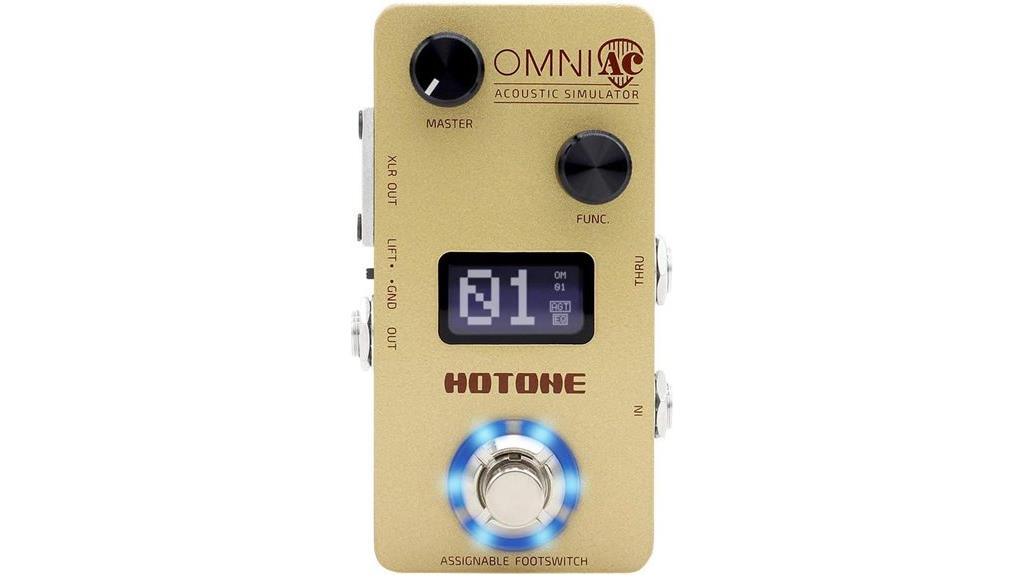
Musicians seeking professional-grade acoustic simulation with extensive tonal variety will find the Hotone Omni AC particularly compelling, as it delivers fifteen distinct high-quality simulations spanning steel strings, nylon strings, acoustic basses, and double basses through its sophisticated 24-bit A/D/A conversion system. You’ll appreciate the detailed four-band EQ with flexible frequency range and 12dB maximum boost/cut, which provides thorough tone-shaping capabilities. The built-in OLED screen displays settings clearly, while the assignable footswitch with LED indicator streamlines performance switching. I’ve found the internal voltage boost circuit guarantees excellent headroom with standard 9V power, and the USB connectivity allows firmware updates plus IR file management through free PC/Mac software.
Best For: Musicians who want to transform their electric guitar or bass into realistic acoustic sounds with professional-quality simulation and detailed tone control options.
Pros:
- 15 high-quality acoustic simulations covering steel strings, nylon strings, acoustic basses, and double basses with 24-bit conversion
- Comprehensive tone control with 4-band EQ, 12dB boost/cut range, and clear OLED display for easy parameter viewing
- Convenient connectivity features including USB for firmware updates, IR file management, aux input, and headphone output
Cons:
- Limited to acoustic simulations only, lacking electric amp modeling or other effect types
- Requires external 9V power supply rather than having rechargeable battery option
- Single footswitch may limit real-time preset switching capabilities during live performance
Stax Guitar Acoustic Simulator Pedal (LEF-320)
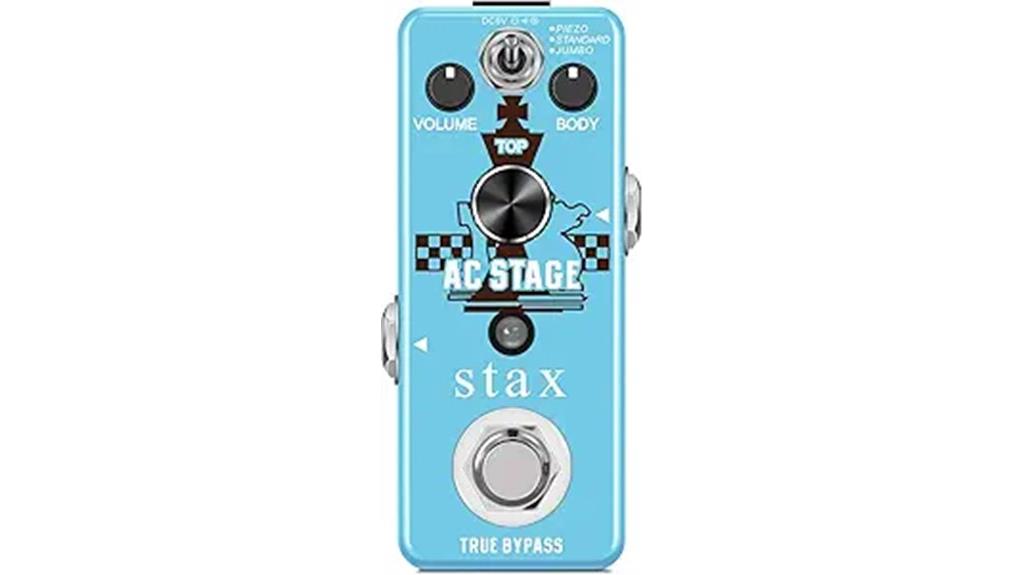
Budget-conscious guitarists seeking versatile acoustic simulation will find the Stax Guitar Acoustic Simulator Pedal (LEF-320) offers three distinct working modes that transform electric guitar signals into convincing acoustic tones. The Piezo mode delivers bright, crisp sounds with reduced body resonance, while Standard mode provides fundamental acoustic character, and Jumbo mode produces full, deep tones that users consistently praise for remarkable sound enhancement. This compact 3.7-inch pedal features true bypass circuitry, analog AC stage processing, and works exceptionally well with electric violins, though you’ll encounter latency issues if you’re expecting pitch-shifting capabilities rather than straightforward acoustic simulation.
Best For: Budget-conscious guitarists who want to add convincing acoustic tones to their electric guitar setup without investing in a separate acoustic instrument.
Pros:
- Three distinct working modes (Piezo, Standard, Jumbo) provide versatile acoustic simulation options
- Compact, lightweight design with true bypass circuitry maintains signal integrity
- Works exceptionally well with multiple instruments including electric guitars and violins
Cons:
- Noticeable latency issues make it unsuitable for pitch-shifting applications
- Mixed customer reviews suggest inconsistent performance and usability
- Requires separate 9V DC adapter purchase as power supply is not included
Factors to Consider When Choosing an Acoustic Pedal Simulator
When I’m evaluating acoustic pedal simulators for electric guitars, I focus on five critical factors that determine whether a pedal will meet your specific performance needs and budget constraints. The sound mode options available, true bypass capabilities for signal integrity, power requirements for your pedalboard setup, overall build quality that guarantees long-term reliability, and price point value all play essential roles in making the right choice. I’ve found that understanding these key considerations before shopping will save you time, money, and the frustration of buying a pedal that doesn’t match your playing style or technical requirements.
Sound Mode Options
Multiple sound modes represent one of the most essential features I consider when evaluating acoustic pedal simulators, as they determine the range of tonal possibilities you’ll have at your disposal. Standard mode typically delivers a balanced acoustic sound that works well across various musical styles, while Jumbo mode emphasizes fuller, deeper tones perfect for richer acoustic renditions. I’ve found Piezo mode particularly useful when I need bright, articulate tones that highlight treble frequencies, mimicking certain acoustic guitar characteristics. This variety considerably enhances the pedal’s versatility, allowing you to customize your tone for different genres and settings. Some models even include built-in reverb effects that complement these acoustic simulations, further enhancing overall sound quality.
True Bypass Feature
True bypass functionality stands as a critical consideration I evaluate when selecting acoustic pedal simulators, since it directly impacts your guitar’s natural tone when the effect isn’t engaged. When I activate true bypass, the signal travels directly from my guitar to the amplifier without any interference from the pedal’s internal circuitry, preserving the original sound quality completely. This feature becomes particularly valuable for musicians who chain multiple pedals together, as each non-bypassed pedal can introduce subtle tonal degradation that accumulates throughout the signal path. I’ve encountered acoustic simulators without true bypass that color the sound even when switched off, creating unwanted tonal shifts that compromise the guitar’s natural character, making true bypass an essential feature for maintaining sound purity.
Power Requirements
Power requirements represent another technical consideration I can’t overlook when evaluating acoustic pedal simulators, as the wrong power setup can undermine even the most carefully preserved signal path from true bypass functionality. Most models operate on standard 9V DC power supplies, though I’ve noticed many manufacturers don’t include adapters in the box, which means budgeting for that extra expense. I appreciate pedals offering battery operation since it provides flexibility for outdoor gigs or cramped stages where power outlets are scarce. The power source directly impacts signal processing quality and overall audio performance, so I always use the manufacturer’s specified supply to avoid unwanted noise or insufficient power delivery that could compromise the acoustic simulation.
Build Quality Construction
Build quality construction separates the pedals I’d trust on tour from those I’d hesitate to use beyond bedroom practice sessions, and I’ve learned this distinction the hard way after watching cheaper units fail during critical performances. I prioritize zinc alloy or aluminum construction because these materials withstand the constant stomping, loading, and environmental changes that live performance demands. True bypass design guarantees my guitar’s natural tone remains uncolored when the pedal’s disengaged, which matters more than many players realize. I also look for rugged switches and jacks, LED indicators for quick visual confirmation, and compact designs that maximize pedalboard real estate while minimizing weight during those inevitable gear hauls between venues.
Price Point Value
Every acoustic simulator on the market falls somewhere between the $25 budget bracket and the $250 premium tier, and I’ve discovered that understanding this price spectrum helps guitarists make smarter purchasing decisions based on their actual needs rather than marketing hype.
Budget models deliver basic acoustic simulation without bells and whistles, which honestly works fine for bedroom players or those just experimenting with the sound. Mid-range pedals, typically $75-$150, offer multiple acoustic voicings, additional effects like reverb, and noticeably better build quality that’ll survive regular gigging.
Premium units justify their cost through advanced digital processing, incredibly accurate acoustic modeling, and customizable presets that let you dial in specific guitar tones. Remember to factor in power supply costs, since many pedals don’t include adapters.
On a final note
I’ve tested countless acoustic simulators throughout my years of playing, and while none perfectly replicate a true acoustic guitar’s resonance and woody character, these pedals offer impressive alternatives for live performance situations. Whether you’re drawn to Boss’s industry-standard reliability, MOOER’s compact versatility, or LEKATO’s modern Bluetooth integration, each simulator serves specific needs and budgets. The key lies in matching your performance requirements with the pedal’s strengths, not expecting miracles.

